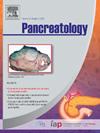怀疑患有慢性胰腺炎的儿童和青年胰腺MRI和内镜超声检查结果之间的关系
IF 2.7
2区 医学
Q2 GASTROENTEROLOGY & HEPATOLOGY
引用次数: 0
摘要
内镜超声(EUS)和磁共振成像(MRI)都用于诊断胰腺炎,但在儿童中,不同方式的结果如何相关尚未明确。我们的目的是描述儿童EUS和MRI胰腺成像结果之间的关系。方法:我们回顾性分析了儿童患者(年龄)。结果:99例患者,其中18例为ARP, 16例为CP作为EUS的指征。平均年龄13.5±4.1岁。Rosemont标准分类为:正常64例(64.7%),不确定19例(19.2%),提示3例(3.0%),一致13例(13.1%)。有ARP指征的4/18 (EUS)和4/18 (MRI)患者和有CP指征的9/16 (EUS)和7/16 (MRI)患者的影像学表现与CP一致。罗斯蒙特标准分级与MRI胰管异常(系数= 0.57 ~ 0.60)和主观胰腺萎缩(系数= 0.57)中度相关。单个EUS和MRI特征之间的相关性非常弱至中等,主管道表现的相关性最高(系数≤0.63)。结论:MRI表现与胰管和实质萎缩相关,与EUS罗斯蒙特标准分级中度相关。单个EUS和MRI表现之间的相关性一般从弱到中度不等,其中主管道表现的相关性最高(系数≤0.63)。本文章由计算机程序翻译,如有差异,请以英文原文为准。
Associations between MRI and endoscopic ultrasound findings in the pancreas in children and young adults with suspected chronic pancreatitis
Introduction
Endoscopic ultrasound (EUS) and magnetic resonance imaging (MRI) are both used to diagnose pancreatitis but how findings relate across modalities has not been defined in children. Our aim is to characterize associations between pancreas imaging findings on EUS and MRI in children.
Methods
We retrospectively reviewed pediatric patients (age <21-years) who underwent EUS January 2019 to December 2023 and had an MRI of the abdomen within 90 days of EUS. MRIs were independently reviewed by three radiologists and EUS reports were reviewed to extract Rosemont Criteria findings. The association between MRI findings, Rosemont Criteria classification, and individual EUS findings was calculated using Pearson correlation coefficients, Pearson contingency test and F-test.
Results
Ninety-nine patients, 18 with ARP, 16 with CP as indications for EUS were included. Mean age was 13.5 ± 4.1 years. Rosemont Criteria classifications were: normal = 64 (64.7 %), indeterminate = 19 (19.2 %), suggestive = 3 (3.0 %), and consistent = 13 (13.1 %). Imaging was consistent with CP in 4/18 (EUS) and 4/18 (MRI) patients with an indication of ARP and 9/16 (EUS) and 7/16 (MRI) patients with an indication of CP. Rosemont Criteria classification was moderately associated with MRI pancreatic duct abnormalities (coefficients = 0.57 to 0.60) and subjective pancreatic atrophy (coefficient = 0.57). Associations between individual EUS and MRI features were very weak to moderate and were highest for main duct findings (coefficient ≤ 0.63).
Conclusion
MRI findings related to the pancreatic duct and of parenchymal atrophy were moderately associated with EUS Rosemont Criteria classification. Correlations between individual EUS and MRI findings generally ranged from weak to moderate and were highest (coefficient ≤ 0.63) for main duct findings.
求助全文
通过发布文献求助,成功后即可免费获取论文全文。
去求助
来源期刊

Pancreatology
医学-胃肠肝病学
CiteScore
7.20
自引率
5.60%
发文量
194
审稿时长
44 days
期刊介绍:
Pancreatology is the official journal of the International Association of Pancreatology (IAP), the European Pancreatic Club (EPC) and several national societies and study groups around the world. Dedicated to the understanding and treatment of exocrine as well as endocrine pancreatic disease, this multidisciplinary periodical publishes original basic, translational and clinical pancreatic research from a range of fields including gastroenterology, oncology, surgery, pharmacology, cellular and molecular biology as well as endocrinology, immunology and epidemiology. Readers can expect to gain new insights into pancreatic physiology and into the pathogenesis, diagnosis, therapeutic approaches and prognosis of pancreatic diseases. The journal features original articles, case reports, consensus guidelines and topical, cutting edge reviews, thus representing a source of valuable, novel information for clinical and basic researchers alike.
 求助内容:
求助内容: 应助结果提醒方式:
应助结果提醒方式:


